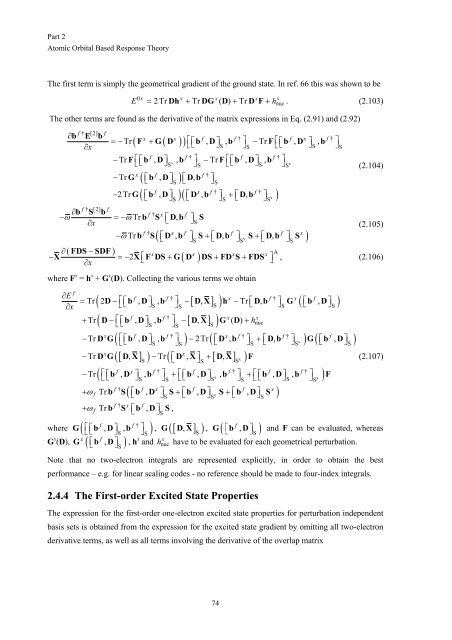Get my PhD Thesis
Get my PhD Thesis
Get my PhD Thesis
Create successful ePaper yourself
Turn your PDF publications into a flip-book with our unique Google optimized e-Paper software.
Part 2<br />
Atomic Orbital Based Response Theory<br />
The first term is simply the geometrical gradient of the ground state. In ref. 66 this was shown to be<br />
E<br />
0 x = 2Tr x + Tr x ( ) + Tr<br />
x + hnuc<br />
x<br />
Dh DG D D F . (2.103)<br />
The other terms are found as the derivative of the matrix expressions in Eq. (2.91) and (2.92)<br />
f † [2]<br />
∂b E b<br />
∂x<br />
f † [2]<br />
f<br />
f<br />
( ( ))<br />
=− Tr F + G D ⎡ , , ⎤ −Tr ⎡ , , ⎤<br />
⎣<br />
b D b<br />
⎦<br />
F<br />
⎣<br />
b D b<br />
⎦<br />
x x f f † f x f †<br />
⎡⎣ ⎤⎦ ⎡ ⎤<br />
S S ⎣ ⎦S<br />
−Tr F⎡⎡⎣ , ⎤⎦ x<br />
, ⎤ Tr ⎡⎡ ⎣ , ⎤⎦<br />
, ⎤<br />
⎣<br />
b D b<br />
⎦<br />
F<br />
⎣<br />
b D b<br />
⎦<br />
f f † f f †<br />
−<br />
S S<br />
S<br />
†<br />
( ⎡ ⎤ ) ⎡ ⎤<br />
S<br />
S<br />
f x f † f †<br />
( ⎡ ⎤ )( ⎡ ⎤ ⎡ ⎤<br />
x )<br />
x f f<br />
− Tr G ⎣b , D⎦ ⎣D,<br />
b ⎦<br />
− 2Tr G ⎣b , D⎦ ⎣D , b ⎦ + ⎣D,<br />
b ⎦<br />
∂b S b<br />
f † x f<br />
− ω<br />
= −ωTr b S ⎡ , ⎤<br />
∂x<br />
⎣D b ⎦ S<br />
S<br />
S S S<br />
( ⎡ ⎤ ⎡ ⎤<br />
x<br />
⎡ ⎤ )<br />
f † x f f f x<br />
⎣ ⎦S ⎣ ⎦S ⎣ ⎦S<br />
− ω Tr b S D , b S+ D, b S+<br />
D,<br />
b S<br />
S<br />
x<br />
S<br />
(2.104)<br />
(2.105)<br />
∂( FDS −SDF<br />
)<br />
x x x x A<br />
− X = − 2X⎡<br />
+ ( ) + + ⎤<br />
∂x<br />
⎣F DS G D DS FD S FDS ⎦ , (2.106)<br />
where F x = h x + G x (D). Collecting the various terms we obtain<br />
f<br />
∂E<br />
∂x<br />
f f † x f † x f<br />
( D ⎡<br />
⎤<br />
⎣<br />
⎡⎣b D⎤⎦ b [ ]<br />
S ⎦<br />
D X<br />
S ) h ⎡ ⎤<br />
S<br />
( ⎡ ⎤<br />
S<br />
)<br />
S<br />
⎣D b ⎦ G ⎣b D⎦<br />
f f †<br />
x x<br />
( D ⎡⎡<br />
⎣b D⎤⎦<br />
b ⎤ [ D X]<br />
) G D hnuc<br />
= Tr 2 − , , − , −Tr , ,<br />
+ Tr −<br />
⎣<br />
, ,<br />
⎦<br />
− , ( ) +<br />
S<br />
S<br />
S<br />
x f f † x f † f †<br />
f<br />
DG( ⎡<br />
⎤<br />
⎣<br />
⎡⎣b D⎤⎦ b ) ( x<br />
S ⎦<br />
⎡<br />
S S<br />
) (<br />
S<br />
)<br />
S ⎣D b ⎤⎦ ⎡⎣Db ⎤⎦ G ⎡⎣b D⎤⎦<br />
x<br />
x<br />
DG( [ DX]<br />
) ( ⎡ ⎤ [ ] x<br />
S ⎣D X⎦<br />
DX<br />
S<br />
S<br />
) F<br />
f x<br />
( ⎡<br />
f † † †<br />
⎡⎣<br />
b D ⎤ , ⎤ ⎡<br />
f f<br />
,<br />
x<br />
, ⎤ ⎡<br />
f f<br />
, , ⎤<br />
⎣ ⎦ b<br />
S ⎦<br />
+<br />
S S<br />
x )<br />
S ⎣⎣ ⎡b D⎦⎤ b<br />
⎦<br />
+<br />
S ⎣⎣ ⎡b D⎦⎤<br />
b<br />
⎦<br />
F<br />
S<br />
f † f x f f x<br />
Tr b S( ⎡b , D ⎤ S ⎡b , D⎤ x<br />
S ⎡b , D⎤<br />
S )<br />
−Tr , , − 2Tr , + , ,<br />
−Tr , − Tr , + ,<br />
− Tr ,<br />
+ ω f ⎣ ⎦ + ⎣ ⎦ + ⎣ ⎦<br />
f † x f<br />
+ ω f Tr b S ⎡⎣b , D⎤⎦<br />
S,<br />
G b D b , ( [ , ] )<br />
where ( ⎡<br />
f<br />
f †<br />
, , ⎤<br />
⎣<br />
⎡⎣<br />
⎤⎦S<br />
⎦ )<br />
S<br />
G x x f<br />
(D), ( ⎡ , ⎤ )<br />
S<br />
S S S<br />
f<br />
G D X , ( ⎡ , ⎤ )<br />
(2.107)<br />
G S ⎣ b D ⎦ and F can be evaluated, whereas<br />
S<br />
G ⎣ b D ⎦ , h x and nuc<br />
x<br />
h have to be evaluated for each geometrical perturbation.<br />
S<br />
Note that no two-electron integrals are represented explicitly, in order to obtain the best<br />
performance – e.g. for linear scaling codes - no reference should be made to four-index integrals.<br />
2.4.4 The First-order Excited State Properties<br />
The expression for the first-order one-electron excited state properties for perturbation independent<br />
basis sets is obtained from the expression for the excited state gradient by omitting all two-electron<br />
derivative terms, as well as all terms involving the derivative of the overlap matrix<br />
74

















